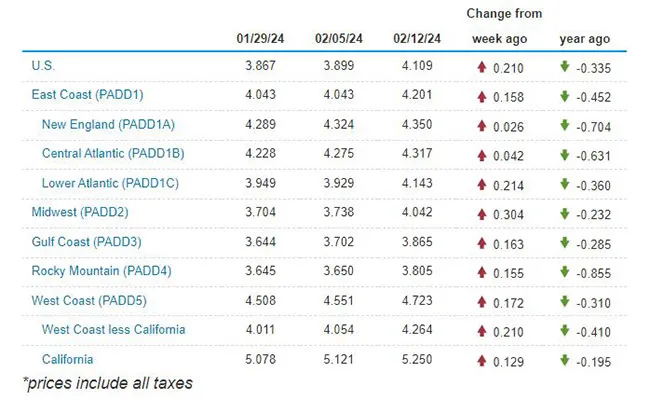Diesel Price Surges 21¢ to $4.109 a Gallon

[Stay on top of transportation news: Get TTNews in your inbox.]
The national average diesel price topped $4 for the first time in 10 weeks, shooting up 21 cents to $4.109 a gallon, according to Energy Information Administration data for the week of Feb.12.
It’s the biggest one-week surge since diesel climbed 22.2 cents a gallon from $3.905 on July 24 to $4.127 on July 31. The last time a gallon of diesel cost at least $4 a gallon was Dec. 4, when it was $4.092.
The current increase is more than triple the gains of the two previous weeks combined (6.1 cents), and a gallon of diesel now costs 33.5 cents less than at this time in 2023.
The average price for a gallon of trucking’s primary fuel increased in all 10 regions in EIA’s weekly survey, ranging from 2.6 cents in New England to 30.4 cents in the Midwest.
U.S. On-Highway Diesel Fuel Prices

EIA.gov
The average price for a gallon of gasoline increased 5.6 cents to $3.192. That’s 19.8 cents less than at this time a year ago.
Even with the increase in diesel and gasoline during the past week, Tom Kloza, founder of the Oil Price Information Service, told Transport Topics that markets in the previous week have been relatively quiet, and the increase in prices can be traced in part to refinery issues.
Earlier this month, a power outage at the BP oil refinery in Whiting, Ind., the largest oil refinery in the Midwest, sparked an emergency response and evacuations. That facility produces an estimated 440,000 barrels per day and could be offline until March.
U.S. average retail prices for February 12, 2024:
Regular grade #gasoline: $3.19/gallon
On-highway #diesel: $4.11/gallon #gaspriceshttps://t.co/dsfxiPA8Wj — EIA (@EIAgov) February 12, 2024
“We’ve had a lot of refining downtime, and it’s been both planned and unplanned maintenance. But not many dynamic things are happening in the oil market right now,” Kloza said. “But diesel fuel is still very tight. The national price ... went above $4 a gallon. I think diesel is still prone to some price spasms on the upside.

Kloza
“However, the amount of diesel that went for home heating oil has been pretty low, and that’s helping supply. It’s been a mostly mild winter, and not using much diesel or home heating oil at a high level.”
On Feb. 14, West Texas Intermediate’s benchmark crude closed at $76.32 a barrel, down from more than $79 a year ago. Oil is substantially lower now than when it reached a one-year high of $93.68 on Sept. 27, 2023, and it’s off its year-to-date high of $78.01 on Jan. 26.
Oil analyst Phil Flynn said that while prices are stable, the nation’s refining capacity dipped significantly in early February, which caused supplies to tighten and prices to increase.
According to EIA, refinery utilization dropped to 80.6% the week ending Feb. 9, down from 92.6% on Jan. 12. In February 2023, utilization was at 85.6%.

Flynn
“Supplies are down, and refinery runs were down big last week,” Flynn said, pointing out these numbers are the lowest since the early days of the COVID-19 pandemic. “Whiting, Ind., is down, and other refineries were in maintenance, and everything hit simultaneously.”
Kloza and Flynn said they anticipate refining capacity to remain tight during the next several weeks. Refineries typically switch operations in late February and early March to produce less-polluting summer blend gasoline.
Because gasoline can evaporate more easily during the summer months, the Environmental Protection Agency requires a lower vapor pressure, reducing air pollution. Typically, summer blend gasoline usually costs 5 cents to 10 cents a gallon more.
We’re challenging the administration’s offshore leasing program that jeopardizes America’s energy future and risks reliance on foreign sources. The @DenverGazette breaks it all down: https://t.co/rSXWu211mc — American Petroleum Institute (@APIenergy) February 15, 2024
While domestic oil production in the U.S. has recently reached a global record at nearly 13.5 million barrels per day, the Biden administration is being criticized by the petroleum industry for its 2024-29 National Outer Continental Shelf Oil and Gas Leasing Program, which oil and gasoline officials claim puts too many restrictions on exploration in the Gulf of Mexico.
COMTO's April Rai offers tips to increase workforce diversity and grow profits.. Tune in above or by going to RoadSigns.ttnews.com.
“Demand for affordable, reliable energy is only growing, yet this administration has used every tool at its disposal to restrict access to vast energy resources in federal waters,” the American Petroleum Institute said in a statement Feb. 12. "In issuing a five-year program with the fewest lease sales in history, the administration is limiting access in a region responsible for generating among the lowest carbon-intensive barrels in the world, putting American consumers at greater risk of relying on foreign sources for our future energy needs.
“Today, we are taking action to challenge this shortsighted program so that future generations of Americans will continue to benefit from our energy advantage for decades to come.”
API said the administration’s efforts would hurt efforts to reduce climate change by restricting oil production in the Gulf because that oil produces some of the lowest carbon-intensity petroleum in the world, and cutting production there might mean replacing that oil with higher-carbon oil from other parts of the world.
Want more news? Listen to today's daily briefing below or go here for more info:





